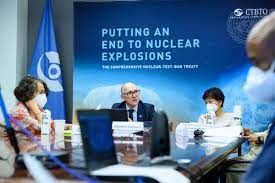What Comprehensive Nuclear Test Ban Treaty ? (CTBT)

What is Comprehensive Nuclear Test Ban Treaty ? (CTBT) Theme : “Ensuring global security: The imperative for (CTBT) Comprehensive Nuclear Test Ban.” It was adopted in 1996, aims to create a world free from the dangers of nuclear . Headline – Negotiated in the Conference on Disarmament in Geneva, the CTBT was adopted by the United Nations General Assembly in 1996. A Brief Overview The Comprehensive Nuclear Test Ban Treaty is an international treaty aimed at prohibiting all nuclear explosions for both military and civilian purposes. However, the treaty has yet to enter into force with some key countries, including nuclear-armed states, as there is no official agreement. What is Comprehensive Nuclear Test Ban Treaty? The (CTBT) has a set of rules, kind of like a big plan. This plan has three parts: Part I: International Monitoring System (IMS) – This is like a global watch system. Countries set up monitoring stations worldwide to keep an eye on nuclear activities. Part II: On-Site Inspections (OSI) – If there’s a suspicion that a country is breaking the rules, this part allows for visits to the suspicious site to check things out in person. Part III: Confidence-Building Measures (CBMs) – This is about building trust between countries. They agree to share information and be transparent to reduce the chances of misunderstandings. CTBT at a Glance: Making the World Safer from Nuclear Tests The CTBT is like a guiding light for world peace. Its main goal is to stop nuclear testing. However, it’s having a tough time becoming a rule because some big countries with nuclear weapons haven’t officially agreed to it. This is causing a problem, and the rule can’t be put into action until they agree. In a pivotal moment during the Conference on Disarmament in Geneva, the Comprehensive Nuclear Test Ban Treaty emerged, officially adopted by the United Nations General Assembly in 1996. This landmark agreement aimed to reshape the nuclear landscape, ushering in an era where all nuclear explosions, whether for military or civilian purposes, would be prohibited. Signing and Ratification: Since its opening for signature in 1996, the CTBT has garnered signatures from 185 countries. Impressively, 170 countries have ratified the treaty, showcasing widespread international support. However, the treaty’s entry into force necessitates signatures from 44 specific countries outlined in Annex 2, including nuclear-capable states like the United States, China, and India. Nuclear Testing History: Before CTBT negotiations, nuclear testing was commonplace. The Limited Test Ban Treaty (LTBT) of 1963 restricted nuclear tests in certain environments but allowed underground testing. The CTBT, in contrast, aspires to eradicate all nuclear explosions, irrespective of location. Nuclear Testing Moratorium: Despite not being in force, the CTBT has wielded influence, prompting voluntary moratoriums on nuclear testing by countries such as the United States, Russia, and China. Monitoring System: It includes a sophisticated monitoring system designed to detect and deter clandestine nuclear testing. This system, though not fully operational, showcases the commitment to transparency and accountability in the pursuit of global nuclear disarmament. Nuclear-Armed States Position: Notably, among the nuclear-armed states, China and the United States have signed but not ratified the CTBT. North Korea, India, and Pakistan have not signed the treaty, raising concerns about the efficacy of the global nuclear non-proliferation regime. Preparatory Commission The Preparatory Commission’s main job is to create a global system for checking if countries are following the rules in the Treaty. They want this system to be ready when the Treaty officially starts. They’re planning to set up a network of 321 monitoring stations and 16 labs around the world. (CTBC) Pros and Cons : Pros: 1)Nuclear Disarmament: This treaty supports global nuclear disarmament by prohibiting nuclear explosions and encouraging reductions in nuclear arsenals. 2)Prevention of Nuclear Proliferation: Aims to curb the development of new nuclear weapons, limiting the proliferation of nuclear capabilities. 3)Environmental Protection: Bans nuclear testing, protecting the environment from radioactive materials and minimizing the risk of nuclear fallout. 4) Global Security: Enhances global security by reducing the potential for nuclear arms races. 5)International Cooperation: Fosters international cooperation, promoting dialogue and collaboration toward a nuclear-free world. Cons: 1)Non-Ratification by Key States: Some major nuclear-armed states like the U.S., China, India, and Pakistan haven’t ratified the CTBT. 2)Verification Challenges: Monitoring and verifying compliance poses challenges, making detection of covert nuclear testing difficult. 3)Impact on Nuclear Deterrence: Critics argue that this may undermine the concept of nuclear deterrence, complicating reliance on nuclear weapons. 4)Technological Advances: Advances in monitoring technologies may enable clandestine, challenging-to-detect low-yield nuclear tests, reducing treaty effectiveness. 5)Uneven Commitment: Its effectiveness relies on universal commitment; non-adherence by some states creates an uneven playing field in nuclear capabilities. Conclusion: It represents effort towards nuclear disarmament and the prevention of further nuclear weapons creation. While progress has been made with widespread signatures and ratifications, the challenges lie in convincing key nuclear-armed states to fully commit. The future of the CTBT depends on the efforts to address concerns, build trust, and ultimately secure the ratifications for its entry into force References: (CTBCO): The Comprehensive Nuclear-Test-Ban Treaty: TEXT OF THE TREATY United Nations Also Read: OpenAI Ousts Sam Altman From CEO and Board Roles; Worldcoin Drops 12% Green growth – The New India
